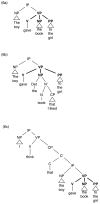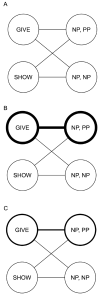Structural priming: a critical review
- PMID: 18444704
- PMCID: PMC2657366
- DOI: 10.1037/0033-2909.134.3.427
Structural priming: a critical review
Abstract
Repetition is a central phenomenon of behavior, and researchers have made extensive use of it to illuminate psychological functioning. In the language sciences, a ubiquitous form of such repetition is structural priming, a tendency to repeat or better process a current sentence because of its structural similarity to a previously experienced ("prime") sentence (J. K. Bock, 1986). The recent explosion of research in structural priming has made it the dominant means of investigating the processes involved in the production (and increasingly, comprehension) of complex expressions such as sentences. This review considers its implications for the representation of syntax and the mechanisms of production and comprehension and their relationship. It then addresses the potential functions of structural priming, before turning to its implications for first language acquisition, bilingualism, and aphasia. The authors close with theoretical and empirical recommendations for future investigations.
(Copyright) 2008 APA, all rights reserved.
Figures


Similar articles
-
Persistent structural priming from language comprehension to language production.Cognition. 2007 Sep;104(3):437-58. doi: 10.1016/j.cognition.2006.07.003. Epub 2006 Sep 14. Cognition. 2007. PMID: 16973143
-
Structural priming from production to comprehension in aphasia.Aphasiology. 2024;38(1):70-91. doi: 10.1080/02687038.2022.2159314. Epub 2022 Dec 23. Aphasiology. 2024. PMID: 38239274 Free PMC article.
-
The development of abstract syntax: evidence from structural priming and the lexical boost.Cognition. 2012 Oct;125(1):49-63. doi: 10.1016/j.cognition.2012.06.008. Epub 2012 Jul 19. Cognition. 2012. PMID: 22986018
-
The P-chain: relating sentence production and its disorders to comprehension and acquisition.Philos Trans R Soc Lond B Biol Sci. 2013 Dec 9;369(1634):20120394. doi: 10.1098/rstb.2012.0394. Print 2014. Philos Trans R Soc Lond B Biol Sci. 2013. PMID: 24324238 Free PMC article. Review.
-
Short-Term and Working Memory Treatments for Improving Sentence Comprehension in Aphasia: A Review and a Replication Study.Semin Speech Lang. 2017 Feb;38(1):29-39. doi: 10.1055/s-0036-1597262. Epub 2017 Feb 15. Semin Speech Lang. 2017. PMID: 28201835 Free PMC article. Review.
Cited by
-
Lexically-specific syntactic restrictions in second-language speakers.J Mem Lang. 2024 Feb;134:104470. doi: 10.1016/j.jml.2023.104470. Epub 2023 Nov 28. J Mem Lang. 2024. PMID: 39301181 Free PMC article.
-
Endogenous Oscillations Time-Constrain Linguistic Segmentation: Cycling the Garden Path.Cereb Cortex. 2021 Jul 29;31(9):4289-4299. doi: 10.1093/cercor/bhab086. Cereb Cortex. 2021. PMID: 33949654 Free PMC article.
-
Female fertility affects men's linguistic choices.PLoS One. 2012;7(2):e27971. doi: 10.1371/journal.pone.0027971. Epub 2012 Feb 8. PLoS One. 2012. PMID: 22347361 Free PMC article.
-
Collective language creativity as a trade-off between priming and antipriming.PLoS One. 2021 Nov 29;16(11):e0259285. doi: 10.1371/journal.pone.0259285. eCollection 2021. PLoS One. 2021. PMID: 34843494 Free PMC article.
-
Priming Sentence Production in Older Adults: Evidence for Preserved Implicit Learning.Aphasiology. 2024;38(1):1-21. doi: 10.1080/02687038.2022.2153326. Epub 2022 Dec 19. Aphasiology. 2024. PMID: 38425351 Free PMC article.
References
-
- Altmann GTM, Kamide Y. Incremental interpretation at verbs: Restricting the domain of subsequent reference. Cognition. 1999;73:247–264. - PubMed
-
- Arai M, Van Gompel RPG, Scheepers C. Priming ditransitive structures in comprehension. Cognitive Psychology. 2007;54:218–250. - PubMed
-
- Barr DJ. Establishing conventional communication systems: Is common knowledge necessary? Cognitive Science. 2004;28:937–962.
-
- Bates E, MacWhinney B. Functionalist approaches to grammar. In: Wanner E, Gleitman LR, editors. Language acquisition: The state of the art. Cambridge: Cambridge University Press; 1982. pp. 173–218.
-
- Berndt RS. Sentence production. In: Rapp B, editor. The handbook of cognitive neuropsychology: What deficits reveal about the human mind. New York: Psychology Press; 2001. pp. 375–396.

